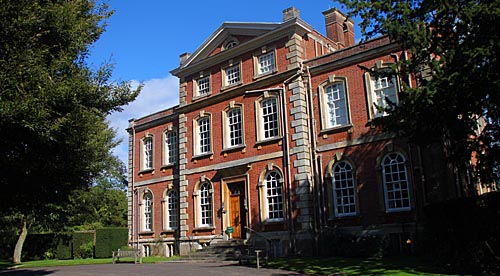 |
 |
|||
|
|
 Kingston
Bagpuize House Kingston
Bagpuize HouseKingston Bagpuize, Berkshire The village's suffix comes from the De Bachepuis family who were lords of the manor from the 11th century. The De Kingstons later took over and evidently took their name from the village. John Latton purchased the estate in 1542. The family's main residences were Symeon's Manor in Chilton and Upton Manor in Blewbury, but they seem to have transferred their allegiance to Kingston Bagpuize around 1570. It may have been around this time that the original John Latton's grandson of the same name built a moated manor house on the present site. The earliest part of the current house, the basement, may have been part of this early house. Elias Ashmole saw the building in the 1660s and commented on the Latton family heraldic glass which appears to have ended up at Horace Walpole's Strawberry Hill. After his death in 1596, John Latton II's widow, Dorothy, married Justice Sir David Williams, a prominent judge who took up residence at Kingston. The Latton family lived in the house for another four generations until 1670, when John Latton IV sold up to Edmund Fettiplace and moved to Esher Place in Surrey. Fettiplace was the newly-married heir of the main Appleton and Besselsleigh branch of this abundant Berkshire family. He seems to have relocated to Kingston Bagpuize and lived there until his death in 1711 when his daughter and heiress, Elizabeth, briefly inherited the estate. It was her widower, John Blandy of Inglewood House (Kintbury), who had the present red brick Baroque house built, around 1715. His architect was probably William Townsend (or his brother, George), an associate of Hawksmoor who worked on Queen's College, Oxford. The former front door on the east side of the house has a parallel at Radley Hall which Townsend also designed and the pediments on all four sides are similar to Hawksmoor's Clarendon Building in Oxford. The flaming urns flanking the pediments come from the Blandy coat of arms. The house has massive walls and was originally a double pile building with central corridor going from front to back and rooms leading off on both sides. Blandy made further alterations around 1728, including the removal of the central corridor and the addition of the cantilevered staircase and the oak panelling in the library and the dining room. Kingston Bagpuize House was apparently, Blandy's favourite property where he wished his male line descendants to reside. Upon hi's death in 1736, his daughter, Elizabeth the wife of William Shaw, should have inherited her mother's property but, in a bizarre switch, Kingston Bagpuize went to her half-brother, John Blandy II, while she took on her father's house at Inglewood. The younger John Blandy is remembered as a great benefactor to the village, for he paid for the rebuilding of the parish church. He was succeeded, in 1791, by Adam Walker, the eight-year-old grandson of his maternal cousin, Margaret Southby (formerly Day). He took on the additional name of Blandy and, later, the name Jenkins was added by his son, John, upon inheriting the fortune of his maternal grand-uncle of that name. It was John Blandy Jenkins who, in 1865, moved the main entrance of the house to the west front, with the drive approaching from the relocated gates to the north, next to the church. The old entrance became the garden front and a ha-ha was constructed around the lawn that was laid over the old paving. The main entrance hall was converted to the present drawing room and the inner staircase hall became the new entrance hall as it remains today. After just over two hundred years at Kingston, the Blandys sold the estate to the wealthy corn merchant, Edward Strauss MP in 1917. He undertook some minor works, adding the Palladian-style mouldings to the small sitting room; but he went bankrupt in 1935. Lord Ebury purchased the house, but four years later, sold it to Miss Marlie Raphael. The house's furniture and fittings were collected by this lady and the family of her niece, Lady Grant & Tweedsmuir, who still live there. Kingston Bagpuize House
is open
to the public during the Summer.
|
|||
| © Nash Ford Publishing 2002. All Rights Reserved. The location of this house is now administered by Oxfordshire County Council. | ||||


